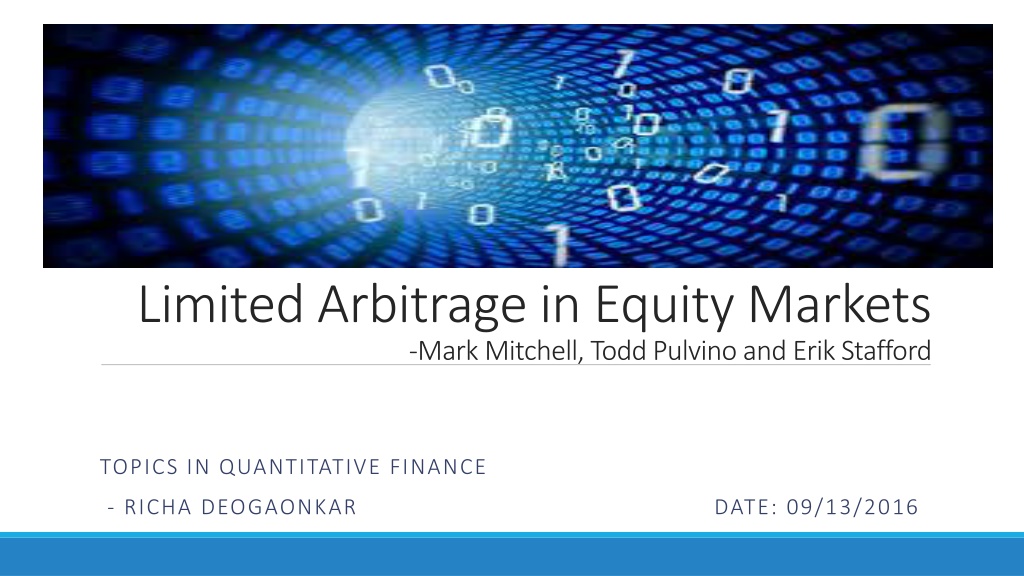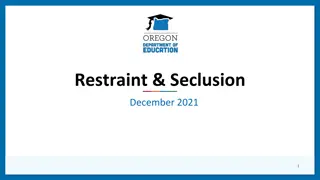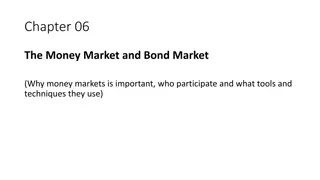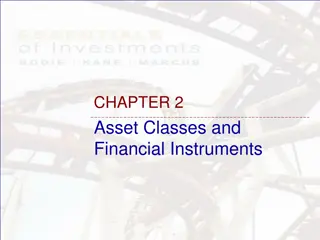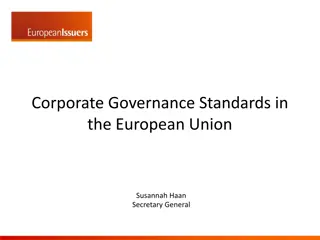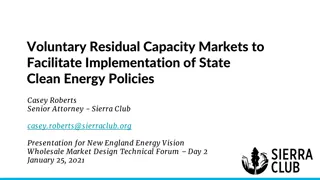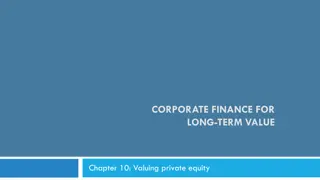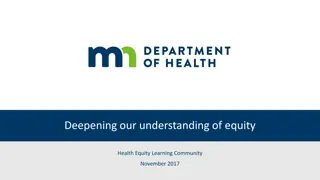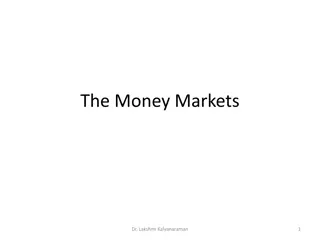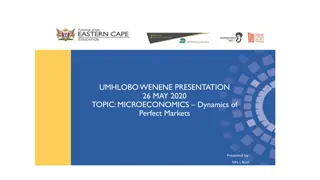Understanding Limited Arbitrage in Equity Markets
This research explores the challenges and impediments faced in arbitrage within equity markets, focusing on factors such as imperfect information, market frictions, and uncertainties. The study examines a sample of 82 companies to analyze negative stubs where the market value of the parent company is less than that of its ownership stake in a publicly traded subsidiary. Data description outlines selection criteria for stub assets and the sample construction process using a two-step method.
Download Presentation

Please find below an Image/Link to download the presentation.
The content on the website is provided AS IS for your information and personal use only. It may not be sold, licensed, or shared on other websites without obtaining consent from the author. Download presentation by click this link. If you encounter any issues during the download, it is possible that the publisher has removed the file from their server.
E N D
Presentation Transcript
Limited Arbitrage in Equity Markets -Mark Mitchell, Todd Pulvino and Erik Stafford TOPICS IN QUANTITATIVE FINANCE - RICHA DEOGAONKAR DATE: 09/13/2016
What is Arbitrage? - True Arbitrage is the simultaneous purchase and sale of an asset to profit from a difference in the price. - A free Lunch?
Contents Contents 1. Introduction 2. Data Description 3. Measuring Investment Return 4. Fundamental Risk 5. Financing Risk 6. Arbitrage in Imperfect Capital Markets 7. Conclusion
Introduction Introduction -To examine the impediments to Arbitrage in Equity Markets - Imperfect Information, Market Frictions Impede, uncertainty over economics, uncertainty over distribution of returns, huge fixed costs, diversification impede Arbitrage - Studied a sample of 82 companies where the market value of the company is less than that of its ownership stake in a publicly traded subsidiary- Negative Stubs
Contents Contents 1. Introduction 2. Data Description 3. Measuring Investment Return 4. Fundamental Risk 5. Financing Risk 6. Arbitrage in Imperfect Capital Markets 7. Conclusion
Data Description Data Description A] Sample Selection Criteria Stub Assets: the market value of the parent's equity less any measurable net assets-net of the parent's unconsolidated liabilities. VStub=MVEquity- MVStake- [MVOtherAssets- MVLiabilities] Rule 1: Vstub<0 if MVStake/ MVParent Equity <1.0 Rule 2: Vstub<0 if MVStake + BV Parent Equity / MVParent Equity <1.0
Data Description Data Description B] Sample Construction Using a two step process- 1. First, we search the Securities Data Corporation (SDC) database from 1985 through 2000 for all initial public offerings (IPO) where another publicly traded firm owned the IPO shares prior to the offering. 2. Second, we search the financial press and trade publications for extreme relative value situations during the 1985 to 2000 period.
Data Description Data Description C] Shares outstanding, Returns and Rebates - To estimate the stub value in cross-holding situations, the number of parent shares outstanding and the number of subsidiary shares held by the parent are needed. - Short rebate refers to the rate paid to investors on the proceeds obtained from short selling a stock. -Short-rebate data from Ameritrade Holding Corporation, a large online re- tail broker. This short-rebate data covers the December 1998 through October 2000 time period.
Contents Contents 1. Introduction 2. Data Description 3. Measuring Investment Return 4. Fundamental Risk 5. Financing Risk 6. Arbitrage in Imperfect Capital Markets 7. Conclusion
Measuring Investment Return Measuring Investment Return A] Investment Criteria and Thresholds Rule 1: Place trade if MVStake/ MVParent Equity > Buy threshold Terminate trade if MVStake/ MVParent Equity < Sell threshold Rule 2: Place trade if MVStake + BV Parent Equity / MVParent Equity > Buy Threshold Terminate trade if MVStake + BV Parent Equity / MVParent Equity <Sell Threshold
Measuring Investment Return Measuring Investment Return B] Investment Capital and Financial Leverage Textbook Leverage: Post Collateral for both long and short positions to satisfy minimum initial capital requirements imposed by Federal Reserve Board. Regulation T Leverage: Sets boundaries for initial maximum amount along with minimum maintenance margin. Conservative Leverage: It precludes all margin calls ex post and cannot be determined ex ante.
Measuring Investment Return Measuring Investment Return C] Assessing Investment Performance - Mean Annualized returns in excess of the risk free rate. - Frequency of negative returns - Frequency of margin calls
Contents Contents 1. Introduction 2. Data Description 3. Measuring Investment Return 4. Fundamental Risk 5. Financing Risk 6. Arbitrage in Imperfect Capital Markets 7. Conclusion
Fundamental Risk Fundamental Risk -In this paper, fundamental risk refers to the possibility that the negative- stub-value trade is terminated before prices converge to fundamental values.
Fundamental Risk Fundamental Risk
Contents Contents 1. Introduction 2. Data Description 3. Measuring Investment Return 4. Fundamental Risk 5. Financing Risk 6. Arbitrage in Imperfect Capital Markets 7. Conclusion
Financial Risk Financial Risk - A] Horizon Risk:
Financial Risk Financial Risk - B] Margin Risk: Creative Computers/Ubid (Subsidiary) - Creative Computer s Total Value- $ 80million - Ubid s total equity value- $439million - Creative Computer s 80% stake- 351 million (Debt of 3 million)
Financial Risk Financial Risk - B] Margin Risk: June 8, 1999 Each Creative Computers shareholder receives 0.7159 UBID share for 1 MALL share December 9, 1998 MALL price is $22.75 UBID price is $35.6875 0.7159*$35.6875 = $25.55
Financial Risk Financial Risk 20 MALL-UBID arbitrage
Financial Risk Financial Risk -Portfolio Results
Financial Risk Financial Risk -C] Specialization of the Arbitrageur - There are many arbitrage funds that engage in "special situations arbitrage," which includes negative-stub- value investments.
Financial Risk Financial Risk
Contents Contents 1. Introduction 2. Data Description 3. Measuring Investment Return 4. Fundamental Risk 5. Financing Risk 6. Arbitrage in Imperfect Capital Markets 7. Conclusion
Arbitrage in Imperfect Capital Markets Arbitrage in Imperfect Capital Markets - Costs of Short Selling and Buy in risks - Imperfect Information and the Persistence of Negative Stub Values
Contents Contents 1. Introduction 2. Data Description 3. Measuring Investment Return 4. Fundamental Risk 5. Financing Risk 6. Arbitrage in Imperfect Capital Markets 7. Conclusion
Conclusion Conclusion The general uncertainty over the distribution of returns is a significant contributor to the persistence of negative stub values. Limitations: (1) statistical reliability of abnormal returns is fairly low and therefore unreliable near the beginning of the sample; (2) Very unusual events cause extreme adverse valuation changes (3) Statistically and economically large price movements occur on the day that uncertainty over the outcome is resolved.
Thank You! Thank You!
